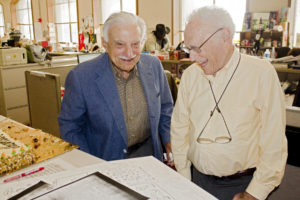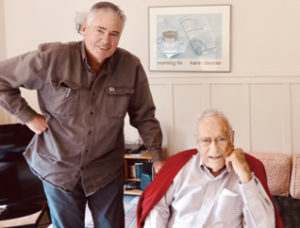Charlie Petit, an accomplished science writer in his own right, worked side by side with the late San Francisco Chronicle legend Dave Perlman, known within journalism as the “dean of American science writing.” Here, Mr. Petit recounts his memories of Mr. Perlman’s exploits in and out of the newsroom.
By Charlie Petit

Dave Perlman in 2011 with his longtime friend and colleague Bill German.
For 26 years, from the early ’70s to late ’90s, I worked alongside and marveled at Dave Perlman’s many
talents, his warmth, his curmudgeonly manner that often came with a wink, his impeccable standards,
and his friendships far and wide. His frequent writing on medical matters led to his City Room moniker,
“Dr. Dave.” He was at the San Francisco Chronicle for an ungodly long time, started there in 1940 as a copy boy and reporter before WWII, returned to the Chron in 1952 as a general assignment guy. He embraced science writing in 1957 — a beat over which he’d eventually reign as its unofficial but revered dean. He didn’t retire until he was 98, in 2017 as the oldest working reporter known in the US press.

Charlie Petit with Dave Perlman
I am still shook by his death on June 19 at age 101. He was my best friend and confidante. So now, as
the great obits have all run (chiefly the Chronicle’s by Steve Rubenstein and Kevin Fagan, and Cristine
Russell’s magnum opus for Scientific American blogs, it is time to put things in order. The obits tend to highlight the recent past 50 years or so. This gives short shrift to a lot of enthusiastic, rambunctious living under his belt before science writing won his heart. I worked as the second banana science writer. He and I used to eat lunch together, often at long-gone Hanno’s in the alley around the corner and at other joints near Fifth and Mission Street. Once in a while he’d tell me an old tale about himself, mainly as a young man or boy. They were wonderful, well-phrased and succinctly told. It dawned on me that I should start making notes. So unbeknown to him at the time, once lunch was over, soon as I had a moment I’d write a few summary lines in a slowly growing digital file. This record all started sometime in the ‘80s. I left the Chron 22 years ago but we remained in close contact.
Cleaned up to correct my sloppy typing and to smooth syntax and rough edges, but otherwise
unchanged is this report on the earlier Dave. / Charlie Petit – June 28, 2020.
FORMATIVE YEARS
♦ He learned his fractured French in France. His Dad wanted a divorce. His Mom wanted a vacation in
France. So she agreed, but only if they’d get a French divorce. That required residence time. So Dave got
dumped into a French grade school for a year at age 6. And Dad got the divorce.
♦ Father Perlman was a psychologist. At age12, he had Dave play the “disturbed child” for his radio
program on mental health for the Mutual Broadcasting Network.
♦ His mother took him, also at about age 12, to see The Front Page, and that was it. During the play’s
introduction he was struck by [and decades later quoted from memory] Ben Hecht’s and Charles
MacArthur’s description of the police beat reporters in the Chicago Newspapers’ collective courthouse
news room: “Seedy, catatonic Paul Reveres, full of strange oaths and a touch of childhood.” Perlman
decided that’s the kind of guy he’d like to be.
♦ He wanted to take physics in high school. His principal told him better not. He’d flunk, and not qualify
for a scholarship. So Dave avoided physics and got a scholarship to Columbia.
♦ In college he took one philosophy course, and that let him into journalism. The course was pass-fail,
and you passed if you showed up. The professor didn’t take attendance so Perlman stopped going,
passed, and spent his time at the Columbia Daily Spectator. He had a roommate also majoring in
government. Dave crammed off his roomie’s notes, and spent all his time at the paper. Wound up
managing editor.
♦ One of his proudest moments as an enterprising newshound at the Spectator: borrowed a stethoscope
and, masquerading as a medical student at Columbia’s College of Physicians and Surgeons, got the inside
scoop on a hospital murder while infiltrating hallways from which the press had been barred. [Many
years later, during a brief stint as city editor at the Chronicle, Perlman refused to hire back a former
reporter on the grounds he had violated ethics while pulling almost precisely the same stunt in
Sacramento.]
SCHENECTADY SUN SUMMER JOB
♦ At age 18, as a summer replacement, he looked through the Sun’s photo files. He managed to put one
in the paper under the hed “Discovered: Judge Crater.” It was a foto of a bum with a made-up story to go
with it. Then he found the bathing beauties file. He made them into a feature art spread: “Zodiac Girls of
Chicago.”
♦ No sooner was he in Schenectady than he was living with the fashion editor. It wasn’t hard to arrange,
as HE was the fashion editor under the byline Wanda Gray.
♦ He made $50 per week, but supplemented it playing the horses. His publisher had the inside word on
which races were fixed. He took his reporters to the track on Sundays. Dave picked up an extra $20 a
week that way.
♦ “Devil’s Island Bared in Schenectady County Jail” the headline said. The sheriff sued for $50,000, but
writer Perlman, who got the story from just one source, had left town bound for the Columbia School of
Journalism.
THE WAR AND POST-WAR
♦ Dave volunteered for the Army after Pearl Harbor. He wanted to be a flier. But he washed out of pilot
school. He flunked the navigation math course.
♦ Lt. Perlman got a desk job in England. Wanted to fight for his country. Volunteered for the infantry. He
got a platoon that had been nearly wiped out at Battle of the Bulge. Never got to the front. His unit
helped guard the bypassed and surrounded German submarine pens along the coast of France. On VE
day, May 8, 1945, he and his crusty veteran platoon sergeant decided to take a look. “Don’t worry
Lieutenant, I can get through these Kraut mines.” So through the perimeter they went. They encountered
a bunch of German officers at an outdoor table having a splendid lunch served to them. The Germans all
jumped up and surrendered. Perlman said “No, no. We’ll do that tomorrow. For now, we wonder if you’d
like to trade. We have cigarettes.” So for a bunch of Lucky Strikes Perlman got a Walther P38 pistol and
his sergeant got a helmet. They caught hell for fooling around with the Germans.
♦ In 1949, freelancing in Europe, covered a show trial in Poland as the Cold War and Iron Curtain were
gestating. He stayed in an old hotel with nothing to see outside but rubble to the horizon. He woke up to
loud pounding on a neighbor’s door. He peeked out to see the cops hustling some shabby character away
into the dark. His lede: “This is the land of the midnight knock on the door.”
♦ Also in 1949 in Iran for Colliers. Princess Ashraf still owes him a $20 canasta bet from a game in
Teheran. He was there to cover the soft underbelly of the West, but had to go back to Paris for son Eric’s
birth.
♦ He and Ann lived in a genuine villa in Paris, overlooking the Seine, with domestic servants and a 2.5-acre garden in the back. Truly the high life. In those days, magazines paid freelancers the same amounts
as today: $1500 and up per article. That was real money back then.
A FEW CHRON ERA YARNS
♦ When he started at the Chronicle, after covering himself in glory as a foreign correspondent, he quickly
learned how much the paper appreciated his talents. His first assignment was to cover the opening of a
Sommer and Kaufman shoe store on Market Street.
♦ In 1952, shortly after he rejoined the Chron, Dave and Ann got some kind of junket first class flight to
New York, on to Rome aboard the posh Vulcania, four days there, first class train to Venice or Naples or
some damned where, then the Andrea Doria on its maiden voyage back to New York. It was a Stan
Delaplane (long time Chron travel writer and columnist) hand-me-down puff piece deal. To save money
Dave filed only a couple hundred words by teletype. The City Room‘s imperious queen bee wordsmith
Carolyn Anspacher blew it up into a travel feature. It left out the most exciting thing of all. There were injuries, including passengers with broken legs, when the dining room furniture slid all over the place in a storm because the ship lacked proper stabilizers.
♦ The Houston Chronicle had a story in 1965 on a NASA Gemini launch. It was Dave’s — Western Union
sent it to the wrong Chronicle.
♦ He and George Dusheck from the News-Call-Bulletin both filed stories from a meeting under the byline
of a heavy-drinking Examiner reporter. He was too drunk to file. He separately asked one and then the
other to do it for him. This prompted confusion. The Ex desk called the news room to ask why it got two
different stories from their guy on the same topic.
Charlie Petit covered science for 47 years as a newspaper, news
magazine, and freelance writer.
His career includes 26 years at the San Francisco Chronicle, starting
in 1972. He left to join U.S. News & World Report in early 1998. After early
2005 he freelanced. His articles have appeared in National Geographic,
Smithsonian Magazine, U.S. News & World Report, Pew Trust, The New
York Times, and Science News.
From early 2006 through August 2014 he worked mainly as a
blogger, or Tracker, gathering and commenting on the day’s mass media
science news stories for a site maintained by the Knight Science Journalism
Fellowships at MIT – where he was a fellow in 1984-85. He read, and
published links to, as many as several dozen stories by his colleagues daily.
A former president of the National Association of Science
Writers, he retired in 2017, but continues some editing work and volunteer
committee activity.
